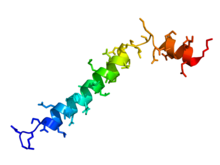Beta thymosins
Monomeric β-thymosins, i.e. those of molecular weight similar to the peptides originally isolated from thymus by Goldstein, are found almost exclusively in cells of multicellular animals.[16] Due to its profusion in the cytosol and its ability to bind G-actin but not F-actin, thymosin β4 is regarded as the principal actin-sequestering protein in many cell types.[17] Thymosin β4 has been tested in multicenter trials sponsored jointly by RegeneRx Biopharmaceuticals Inc (Rockville, MD, USA) and Sigma Tau (Pomezia, Italy) in the United States and Europe in patients with bed sores, ulcers caused by venostasis, and Epidermolysis bullosa simplex and was found to accelerate bed sore and stasis ulcer repair by one month.[19] These proteins, which typically contain 2-4 repeats of the β-thymosin sequence, are found in all phyla of the animal kingdom, with the probable exception of sponges[21] The sole mammalian example, a dimer in mice, is synthesised by transcriptional read-through between two copies of the mouse β15 gene, each of which is also transcribed separately.[26] The phosphorylation of Csp24, in common with post-translational modifications of a number of cytoskeleton-related proteins may contribute to actin-filament dynamics underlying structural remodeling of responsive cells.

intrinsically unstructured proteinsalpha helixorthologuethymosin β4thymusthymosinsInterProPROSITEPDBsumMonomericGenomicstetrapodsTMSB4XTMSB10TMSB15ATMSB15BBony fishChr. XTMSB4YChr. YChr. 2ubiquitinamino acid sequenceWH2 moduleWiskott-Aldrich syndrome proteinX-ray crystallographyconvergent evolutionThymosin beta-4Thymosin α1cytosolbed soresvenostasisEpidermolysis bullosa simplexprostate cancerNMR structureN-terminusC-terminusDrosophilaHermissenda crassicornissensory neuronsBibcodeHormonesEndocrineglandsHypothalamic–pituitaryHypothalamusDopamineSomatostatin (GHIH)Posterior pituitaryOxytocinVasopressinAnterior pituitaryProlactinEndorphinsLipotropinAdrenal axisAldosteroneCortisolCortisoneDHEA-SAndrostenedioneAdrenalineNorepinephrineThyroidThyroid hormonesCalcitoninThyroid axisParathyroidGonadal axisTestisTestosteroneInhibinEstradiolProgesteroneActivinRelaxinPlacentaEstrogenPancreasGlucagonInsulinAmylinSomatostatinPancreatic polypeptidePineal glandMelatoninN,N-Dimethyltryptamine5-Methoxy-N,N-dimethyltryptamineBeta thymosinsThymopoietinThymulinDigestive systemStomachGastrinGhrelinDuodenumSecretinMotilinEnteroglucagonPeptide YYInsulin-like growth factorAdipose tissueLeptinAdiponectinResistinSkeletonOsteocalcinKidneyCalcitriolProstaglandinNatriuretic peptide